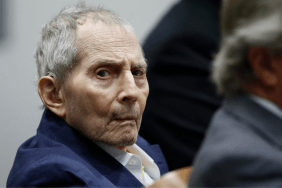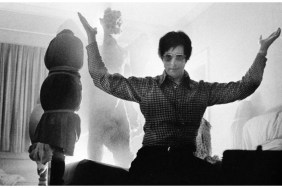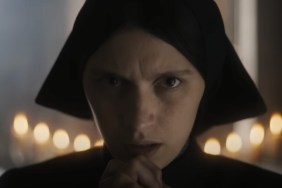
WF: How long have you been covering film?
Almost ten years.
WF: Do you know the name of one person on the ratings board? And forget the head, I mean the people on the board.
No. Does anybody?
WF: No and that’s my point. If you had a child you’d probably know the name of his/her school teacher that was putting ideas into your child’s head. You’d know the name of this person if they said to your child, “The government is terrible” or “We have to replace the President” or “We should keep the President.” You would know the name of the person that told your child that and if you disputed it you’d know where to go.
I’ve been in this business 45 years and I don’t know the names of anybody [on the MPAA board], I don’t even know where they come from. They’re an anonymous group of people that are usually the friend of a friend appointed by somebody who has the power to appoint and what qualifies them I have no idea.
There are qualifications to become a teacher or you have to be elected to become a representative to start making laws, but to become a member of the ratings board what are their qualifications to make these judgments? I can’t take them seriously. It’s a big shock. It’s a self-governing body of the Motion Picture Association of America and name me another NC-17 picture that’s made by a major studio.
WHO ARE THE RATERS?
In a word — parents. Movie ratings are determined by a full-time Board of eight to 13 parents. Raters have no prior film industry affiliation. And all share the common prerequisite experience of parenthood. Raters work for the Classification and Rating Administration, which operates independently by submittal fees it charges to rate films.
Most raters’ identities remain anonymous to shield them from outside pressures and influence. These raters are parents of children between the ages of 5 and 17. The Rating Board is led by senior raters who administer the process, whose identities are made public in order to increase transparency in the system and to enable them to communicate directly with filmmakers and the movie-going public. As reflected by their experience, these raters may have older children.
via MPAA
Well, made by is the big thing, because I could point to Shame, which Fox Searchlight picked up.
WF: They picked it up. They released it as an NC-17, but they didn’t make it. There hasn’t been an NC-17 because the major studios control the ratings board and my distributor (LD Entertainment) is not a member of the MPAA, but they still live by those governing rules.
The point is we don’t know who the members of the rating board are so how can we respect what they do? We can’t! I don’t respect what they do.
Look, you know this fellow J.J. Abrams; he’s directed some really interesting films. I had dinner with him a couple of months ago and he told me he had seen The Exorcist when he was seven-years-old. His father took him to see it. It certainly didn’t ruin his life and it inspired him and he’s had a wonderful career.
The ratings board says no child under the age of 17 can see an NC-17 picture even accompanied by their parent. So they are telling parents what they can and cannot expose their children to. And who the hell are they?

Have things changed at all over the years? Have you noticed a difference in the way films are rated?
WF: Well The Exorcist got an automatic R from that ratings board without one frame cut. The Exorcist would get an automatic NC-17 today. The board goes through phases where there are liberals primarily and conservatives. Right now, and for many years, it has been a conservative board.
You take a film like the American version of The Girl with the Dragon Tattoo. That has an anal rape scene, it has a scene where she seeks retribution against the guy who raped her and cuts him up and it’s very graphic and bloodier than anything in Killer Joe and it got an R.
No one can figure out what their reasoning is because there are no written rules. There’s not one thing that says, “If you do this you’ll get an NC-17, or if you do that.” There’s no rule book. It’s totally subjective on the part of these anonymous regulators who are appointed by their friends who have some job somewhere, either at a major studio or in the MPAA or a lawyer or somebody. You go before a faceless board and guess what; the major studios don’t get an NC-17. They go in and shave a few frames here and there.
I’m guessing the Dragon Tattoo movie had to go in and cut some stuff in order to satisfy the ratings board to give them an R-rating instead of an NC-17. I’m certain in my mind they made some cuts and it came to the ratings board more graphic than when it left.
While Friedkin has zero respect for the MPAA he does say he’s not sorry Killer Joe received an NC-17 rating, “We’re not targeting young teenagers for this movie,” he said. “I don’t think young teenagers should be able to get in to see it, so I’m not really against it in that sense.”
Of course, it’s not so much about should they or should they not see it that clearly gets under Friedkin’s skin, it’s the idea a group of anonymous individuals are determining what our children should and shouldn’t see and on Friday, July 27 Killer Joe will be released in theaters as an NC-17 rated film, which not only means children under the age of 17 can’t go see it, even if accompanied by a parent, but it limits the advertising possibilities for the film as there are regulations placed on NC-17 rated films and some theaters, such as AMC and Regal, won’t even allow an NC-17 rated film in their theaters.
That does it for this first part in my interview with William Friedkin. Tomorrow I’ll bring you our discussion of his previous films including a look back at The French Connection, The Exorcist, Cruising, Sorcerer and Rampage. For now, I’ve included the trailer for Killer Joe directly below and you can get more on the film right here.









